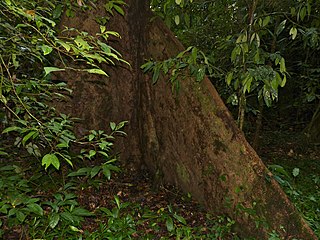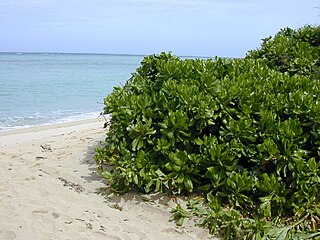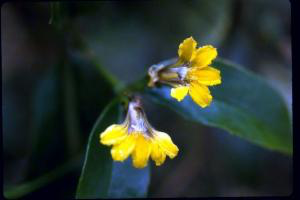
Scaevola is a genus of flowering plants in the Goodenia family, Goodeniaceae. It consists of more than 130 species, with the center of diversity being Australia and Polynesia. There are around 80 species in Australia, occurring throughout the continent, in a variety of habitats. Diversity is highest in the South West, where around 40 species are endemic.

The ginkgo-toothed beaked whale is a poorly known species of whale even for a beaked whale, and was named for the unusual shape of its dual teeth. It is a fairly typical-looking species, but is notable for the males not having any scarring.
Elaeocarpus inopinatus is a species of flowering plant in the Elaeocarpaceae family. It is a tree endemic to Borneo where it is confined to Sabah.
Voanioala gerardii, commonly known as the forest coconut, is a species of flowering plant in the family Arecaceae. It is a relative of the coconut, and is generally regarded as monotypic within the genus Voanioala. However, a team of geneticists headed by Bee F. Gunn found sufficient genetic variation within Voanioala to constitute at least two and possibly four cryptospecies. Voanioala is endemic to Madagascar, and is threatened by habitat loss. Voanioala is harvested for its edible seeds and palm heart. It is estimated that there are fewer than fifteen mature trees remaining.
Melicope sororia is a species of plant in the family Rutaceae. It is endemic to Borneo where it is confined to Sabah.
Monanthocitrus oblanceolata is a species of flowering plant in the citrus family, Rutaceae. It is endemic to Sabah in Malaysia. It was first described in 1988.

Octomeles is a monotypic genus of plant in family Tetramelaceae. The sole species is Octomeles sumatrana, sometimes written O. sumatranum.
Scaevola muluensis is a species of plant in the family Goodeniaceae. It is endemic to Borneo where it is confined to Sarawak. This plant was first described in 1993 by the botanist Khoon Meng Wong in the journal Sandakania.
Scaevola verticillata is a species of plant in the family Goodeniaceae. It is endemic to Borneo where it is confined to Sarawak.
Shorea symingtonii is a species of plant in the family Dipterocarpaceae. It is endemic to Sabah in Borneo.

Fuxian Lake stretches out through Chengjiang, Jiangchuan and Huaning Counties in Yunnan Province, spanning an area of 212 square kilometers. The lake is ranked third-largest in Yunnan, after Dian Lake and Erhai Lake. Also the deepest lake in Yunnan, it is 155 meters deep at its greatest depth. It is also the third-deepest fresh water lake in China, after Tianchi and Kanas Lake.

Scaevola taccada, also known as beach cabbage, sea lettuce, or beach naupaka, is a flowering plant in the family Goodeniaceae found in mangrove swamps and rocky or sandy coastal locations in the tropical areas of the Indo-Pacific. It is a common beach shrub throughout the Arabian Sea, the tropical Indian Ocean and the tropical islands of the Pacific Ocean.
Dipterocarpus ochraceus is a tropical rainforest tree endemic to Sabah. It is known from the ultramafic hills in the Ranau district.
Cinnamosma madagascariensis is a species of flowering plant in the family Canellaceae. It is endemic to Madagascar., where it is known as sakaihazo.

Scaevola canescens is a species of plant in the family Goodeniaceae. It is endemic to Western Australia where it occurs "from Shark Bay to Perth, in open forest and heath in sandy soil".

Scaevola acacioides, is an erect, spreading shrub in the family Goodeniaceae.

Scaevola plumieri is a species of plant in the family Goodeniaceae which grows on coastal dunes in the tropics and subtropics.
Minyichthys inusitatus, also known as the West Atlantic pipefish is a species of marine fish belonging to the family Syngnathidae. They have been be found off the coast of Panama and Northern Argentina, though little is known about their full geographic range or preferred habitat in these areas. Minyichthys inusitatus is thought to live primarily at depths of greater than 30–40 meters. Their diet likely consists of small crustaceans such as copepods, amphipods, and mysid shrimps. Reproduction occurs through ovoviviparity in which the males brood eggs before giving live birth. This small species grows only to lengths of around 2.9 cm on average.

Scaevola enantophylla, commonly known as climbing fan-flower,is a species of flowering plant in the family Goodeniaceae and is endemic to Queensland. It is a scrambling vine with yellow fan-shaped flowers, and the only species in the genus with leaves arranged opposite.









